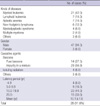1. Driscoll T, Nelson D, Steenland K, Leigh J, Concha-Barrientos M, Fingerhut M, Prüss-Ustün A. The global burden of disease due to occupational carcinogens. Am J Ind Med. 2005. 48:419–431.
2. Siemiatycki J, Richardson L, Straif K, Latreille B, Lakhani R, Campbell S, Rousseau MC, Boffetta P. Listing occupational carcinogens. Environ Health Perspect. 2004. 112:1447–1459.
3. Koh DH. Epidemiologic survey on irregular construction maintenance workers in Yeosu and Kwangyang industrial complex. 2010. Incheon, Korea: Korea Occupational Safety and Health Agency.
5. Korea Radioisotope Association. Statistics on the Radiation Practices in Korea. 2009. Seoul, Korea: Korea Radioisotope Association.
6. Korean Industrial Health Association. Annals of Korean Industrial Health Association, 30th Anniversary. 1993. Seoul: Korean Industrial Health Association.
7. Kang SK, Ahn YS, Chung HK. Occupational Cancer in Korea in the 1990s. Korean J Occup Environ Med. 2001. 13:351–359.
8. Kang SK, Yang JS, Kim KS, Kim Y, Choi JK, Ahn YS, Jin YW, Choi BS, Kim E, Chae CH, Choi YH. Analysis of claimed cases as an occupational disease at Korea Occupational Safety and Health Agency from 1992 to 1999. Korean J Occup Environ Med. 2000. 12:292–301.
9. Ahn YS, Kang SK, Kwon HG, Chung HK. Analysis of occupational disease by approved Korea Labor Welfare Corporation in 1999. Korean J Occup Environ Med. 2001. 13:449–460.
10. Ahn YS, Kang SK, Kim KJ. Analysis of occupational diseases compensated with the industrial accident compensation insurance from 2001 to 2003. Korean J Occup Environ Med. 2004. 16:139–154.
11. Ahn YS. Occupational malignant lymphohematopoietic diseases compensated under the industrial accident compensation insurance from 1996 to 2005. Korean J Occup Environ Med. 2007. 19:81–92.
12. Lim HS, Cheong HG, Kim SK, Park BC, Lee G. A case of acute myelogenous leukemia occurring in a nuclear power plant worker. 2002. Gyongju, Korea: Medical Institute of the Dongguk University.
13. Baak YM, Ahn BY, Chang HS, Kim JH, Kim KA, Lim Y. Aplastic anemia in a petrochemical factory worker. Environ Health Perspect. 1999. 107:851–853.
14. Ahn YS, Park RM, Koh DH. Cancer admission and mortality in workers exposed to ionizing radiation in Korea. J Occup Environ Med. 2008. 50:791–803.
15. Ahn YS, Park RM, Stayner L, Kang SK, Jang JK. Cancer morbidity in iron and steel workers in Korea. Am J Ind Med. 2006. 49:647–657.
16. Cho SH, Kang DH, Ko KS, Kwon HJ, Kim DH, Ha MH, Han SH, Ju YS. Estimates of occupational cancer in Korea. J Occup Health. 1997. 39:192–196.
17. Jung KW, Won YJ, Park S, Kong HJ, Sung J, Shin HR, Park EC, Lee JS. Cancer statistics in Korea: incidence, mortality and survival in 2005. J Korean Med Sci. 2009. 24:995–1003.
18. Ahn Y. Development on a cohort for the workers exposed occupational carcinogen (II). 2006. Incheon, Korea: Occupational Safety and Health Research Institute, Korea Occupational Safety and Health Agency.
19. Korean Statistical Information Service. Statistics of national survey on mining and manufacturing industries 2010 Contract No.: 23, NOV.
20. Levin ML. The occurrence of lung cancer in man. Acta Unio Int Contra Cancrum. 1953. 9:531–541.
21. Drew D, Harkins DK, O'Connor R, Pharagood-Wade F, Tucker P. Case Studies in Environmental Medicine (CSEM): Benzene Toxicity. 1992. updated June, 2000; cited 2010 19th MAY, 2010. USA: Agency for Toxic Substance & Disease Registry;Available at
http://www.atsdr.cdc.gov/csem/benzene/index.html.
22. Korea Statistical Information Service. Trend of the mortality by cause of death. 2009. accessed on 25 May 2010. Available at
http://www.index.go.kr/.
23. The International Agency for Research on Cancer I. Attributable causes of cancer in France in the year 2000. 2007. Lyon, France: World Health Orgainzation, International Agency for Research on Cancer.
24. Park SC, Cheong YH, Kim JJ, Kang OH. Study on the Successful Turnover and Employment. 2009. Seoul, Korea: Korea Employment Information System.
25. Cardis E, Gilbert ES, Carpenter L, Howe G, Kato I, Armstrong BK, Beral V, Cowper G, Douglas A, Fix J. Effects of low doses and low dose rates of external ionizing radiation: cancer mortality among nuclear industry workers in three countries. Radiat Res. 1995. 142:117–132.
26. Cha CW, Kim KJ, Kim JC, Paik NW. Development of technology for environmental assessment and biological monitoring of workers exposed to benzene. Korean J Occup Environ Med. 1994. 6:122–133.
27. Brüske-Hohlfeld I. Occupational cancer in Germany. Environ Health Perspect. 1999. 107:Suppl 2. 253–258.
28. Merler E, Vineis P, Alhaique D, Miligi L. Occupational cancer in Italy. Environ Health Perspect. 1999. 107:Suppl 2. 259–271.




 PDF
PDF ePub
ePub Citation
Citation Print
Print







 XML Download
XML Download